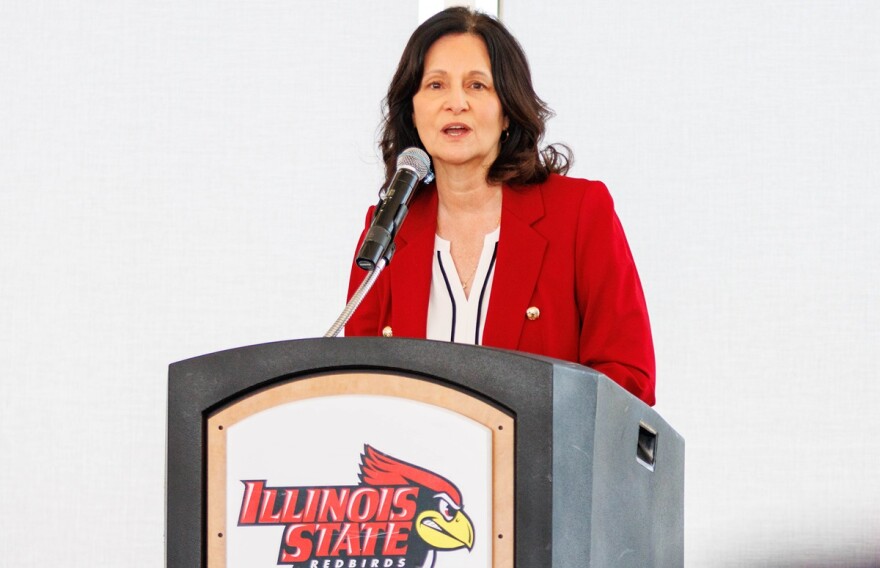Illinois State University Athletics has announced it will opt in to a settlement allowing direct revenue sharing with student-athletes.
July 1 marks the first day colleges and universities can make direct payments to athletes through Name, Image and Likeness [NIL] deals.
The decision stems from a settlement with the NCAA involving student compensation, previously from NIL deals being permitted for student-athletes.
ISU Athletics Director Jeri Beggs said ISU needs to move its NIL in-house to remain competitive.
“Right now if you can’t offer a decent NIL package to a men’s basketball player or women’s basketball player, they won’t come here. In order to be competitive, we have to stay in the game,” Beggs said.
Schools were required to declare their plans to opt in or not by June 30.
Beggs said the university originally considered waiting a year to opt in because the new rules create roster limits that initially put the futures of some current players in jeopardy.
“The new roster cap in football was 105; at that time we had 117 young men on our football team, so 12 of them would have to have been basically kicked off the team, removed from the team,” Beggs said in an interview on WGLT’s Sound Ideas. “But the judge back in April decided that she would allow for some grandfathering, so you didn’t just have to make that hard cut.”
ISU’s Empower the Nest collective has operated since 2022, working to connect student-athletes across all university sports with NIL deals in the community. Beggs said she isn’t yet sure how the collective will fit in now, given that schools can pay student-athletes directly.

“We’re going to take it a little slower, see how everyone else is doing it and of course there will be conversations with campus,” Beggs said. “We’ll have to talk to the [ISU] foundation; we’ll have to talk to the financial people in order to get this done."
Beggs said while some universities have disbanded their collectives, she said it’s likely Empower the Nest can still help ISU.
“They’ll still probably play that role of trying to help us raise dollars that serve our men’s basketball program, our women’s basketball program, our football program,” she said.
Beggs said NIL deals are the most popular among men’s and women’s basketball and football. She said coaches will still be a crucial part of the recruiting process and retaining players.
“They’re the ones who know we need a power forward, they know what they need, and they probably have an even better idea of what the going rate is,” Beggs said.
The NCAA settlement is expected to cost ISU athletics about $5 million over 10 years, to cover compensation denied to former athletes from the so-called Power 4 conferences [Big Ten, Big 12, Atlantic Coast Conference, Southeastern Conference.]
Former ISU athletes will not receive compensation.
Beggs thinks the ISU community has the donor base and community engagement to compete with other schools in attracting and retaining top athletes.
“I think winning will help, anytime your program is on an upswing. We went to the playoffs in football last year, our women’s basketball team has been good for many years in a row, men’s basketball has really high expectations for next year,” Beggs said. “That all helps, because you sell tickets, you get donations, you get sponsorships all around winning programs.”
Beggs said one of the difficulties with students being attracted to those deals is they tend to not stay as long at a school, noting in the past, some fans have expressed disappointment with not being able to build a four-year relationship with players.
“That is hard on our fans because they don’t get a chance to kind of have a favorite and engage and invest in that student-athlete,” she said. “I don’t know how you solve for that, because if you are really good and have a winning team the chances, you’re going to lose your coach and half your players."
The NCAA has capped what each school can spend on NIL deals at $20.5 million. While Beggs said mid-major schools won’t come close to that, it could lower compensation on the high end at some top programs.
“Getting over $1 million in our collective is a goal for us. Each team has its own needs, but the numbers keep going up every year,” she said.
It’s unlikely, she added, that many schools will consider dropping from Division I to non-scholarship Division III [St. Francis University of Pennsylvania did earlier this year] because of the increased financial demands on already cash-strapped schools.
“It’s really hard for a university to give up the status of being a D-I institution. Athletic directors get fired over that, presidents even possibly. It’s a big deal,” she said adding it’s more likely schools will look to cut non-revenue sports if they feel a financial pinch.
Beggs said ISU does its best to support all 19 sports, but said you can never rule out the possibility of reductions in the future.
“We are going to struggle in the coming years because of finances,” she said.
Beggs said NIL payments are not subject to Title IX guidelines. According to new guidelines from the Trump administration, universities need to ensure male and female athletes have equal access to NIL opportunities.



